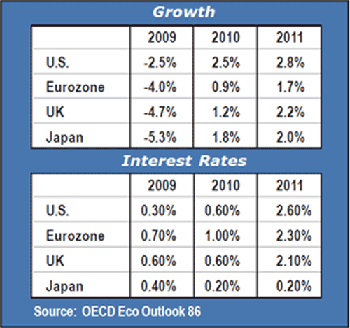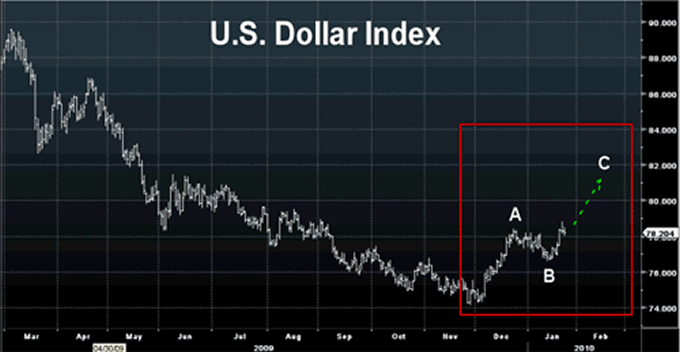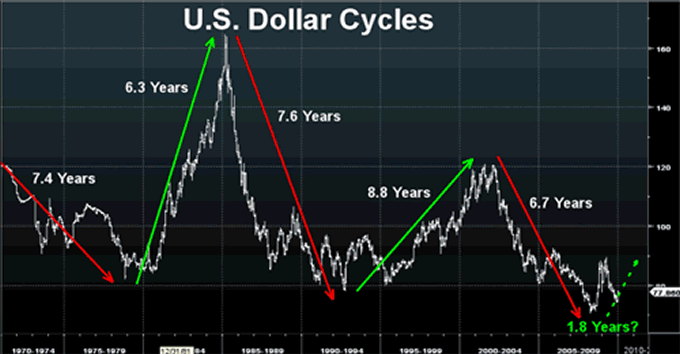Why the U.S. Dollar Rally Has Legs
Currencies / US Dollar Jan 23, 2010 - 03:13 PM GMTBy: Bryan_Rich
 In December I wrote a Money and Markets column making the case for a bottom in the dollar. And since then the evidence supporting that thesis has grown. I also said there are plenty of ugly currencies out there that will likely take scrutiny away from the dollar. In fact, in recent weeks I outlined the blemishes burdening three key major liquid currencies. And those blemishes are now being exposed …
In December I wrote a Money and Markets column making the case for a bottom in the dollar. And since then the evidence supporting that thesis has grown. I also said there are plenty of ugly currencies out there that will likely take scrutiny away from the dollar. In fact, in recent weeks I outlined the blemishes burdening three key major liquid currencies. And those blemishes are now being exposed …
Just eight weeks ago, the pontificators were targeting a break of the all-time highs for the euro … parity for the Australian dollar … resurgence in the British pound … and a return to record highs in the yen.
But since then, the tables have turned. The dollar index has rallied 6 percent, and all of the previously favored currencies are falling!
And the euro, the second most widely held currency in the world, has fallen sharply under the weight of its own problems — losing 7.5 percent against the dollar in just eight weeks.
In short, the U.S. dollar has gone from the most hated currency in the world to one receiving remarkably little attention lately. That’s because it’s stopped declining and is now rising. Not surprisingly, price alone has exposed the lack of conviction in the dollar bear camp.
 |
| The fundamental and technical evidence points to a rebounding U.S. dollar. |
But even in the face of a landslide of negative sentiment and the gradual, yet steady, decline of 2009, I’ve maintained my view that the dollar is not on a path for destruction; rather the weight of fundamental and technical evidence favors the greenback.
The Fundamental Evidence …
Exhibit A: No alternatives
First, the case made for the vulnerability of the dollar falls short when it comes to naming alternatives, as I laid out in my November columns, “Weighing the Dollar Alternatives” and “Weighing the Dollar Alternatives: Part II.”
If you believe the policy responses in the U.S. to the financial crisis should cause the dollar to crater, you must ask yourself: Against what?
The emergency stimulus response has been global. And most likely ALL currencies will fall in value relative to hard, tangible assets like gold, real estate and other commodities … even financial assets like stocks and bonds, if central banks around the world fail to manage exit strategies well.
But currency values are determined only relative to the value of other currencies. And with that in mind, the dollar is positioned, on a relative basis, to perform quite favorably. In fact, I’ve been suggesting a win-win scenario is shaping up for the dollar.
And that leads me to …
Exhibit B: Growth and interest rates
Growth and interest rate differentials are key drivers in determining how capital flows around the world.
Within that framework, let’s take a look at the projections for growth and interest rates from the Organization of Economic Cooperation and Development (OECD) for final 2009, 2010 and 2011:

As you can see, the U.S. is expected to outperform other major economies and move rates higher and at a faster rate of change. Plus, based on these fundamental drivers of currency values, the dollar is now gaining favor from the perception of growth and yield advantage.
And now …
Exhibit C: Flight to safety
The problems in the global economy still exist and threaten the sustainability of global recovery. And those risks are acting as potential time-bombs that could derail a recovery. That makes global investors nervous. When they’re nervous they want to own dollars.
We have endured the deepest and broadest global recession since the Great Depression. Over 65 countries were simultaneously in recession. And global investors responded to the uncertainty by plowing money into the deepest, most liquid market in the world — the U.S. Treasury market.
The dollar and dollar-denominated assets represented safety and liquidity then, and will continue to serve in that function as the looming risks threaten the sustainability of a global recovery. Those risks include:
- Increasingly threatening sovereign debt problems,
- More liquidity-induced asset bubbles,
- And rising protectionism and geopolitical unrest.
The bubbling of these risks all present a scenario that would likely fuel greater demand for dollars.
In addition to the fundamental evidence, the case for a continuation of the recent rise in the dollar is strengthened on a technical basis …
The Technical Evidence …
Exhibit D: Trend reversal
Technically, the dollar is positioned to continue higher. On Thursday, the dollar index surpassed its December highs, confirming an impulsive C-wave of a corrective A-B-C Elliott Wave structure.

Source: Bloomberg
Without getting into all the technical jargon, this particular indicator projects a move to at least 81.50. That’s 4 percent higher from current levels and nearly 10 percent higher from the November lows.
Exhibit E: Beginning of bull market cycle
The long-term cycles suggest the dollar could be in the early stages of a multi-year bull market, too.

Source: Bloomberg
The weekly chart above shows the peak-to-trough cycles of the U.S. dollar. Since the failure of the Bretton Woods system, there have been five distinct cycles in the dollar that have lasted an average of 7.4 years.
Comparing the lengths of prior cycles argues that a new bull cycle began in March of 2008, with the risk aversion rush into the dollar. If that’s true, the sustainability of dollar strength could surprise a lot of people.
Lastly, There’s the Market’s Perception …
Currency markets are very sensitive to general market focus. The focus of market participants was intently on the U.S. for much of 2009, scrutinizing all of the policy decisions, selling the U.S. dollar and ignoring the status of the rest of the world. But now the focus has changed …
Indeed, a Bloomberg poll taken this week is indicative of how quickly perception can shift. According to the poll, investors have turned bullish on the U.S., a stark contrast from the views just a quarter ago. And 62 percent think that China — the recently loved “growth engine” of the world — is a bubble.
So it turns out the rest of the world isn’t in such good shape. And comparatively speaking, I think the U.S. and the dollar look pretty darn good.
Regards,
Bryan
This investment news is brought to you by Money and Markets. Money and Markets is a free daily investment newsletter from Martin D. Weiss and Weiss Research analysts offering the latest investing news and financial insights for the stock market, including tips and advice on investing in gold, energy and oil. Dr. Weiss is a leader in the fields of investing, interest rates, financial safety and economic forecasting. To view archives or subscribe, visit http://www.moneyandmarkets.com.
© 2005-2022 http://www.MarketOracle.co.uk - The Market Oracle is a FREE Daily Financial Markets Analysis & Forecasting online publication.



